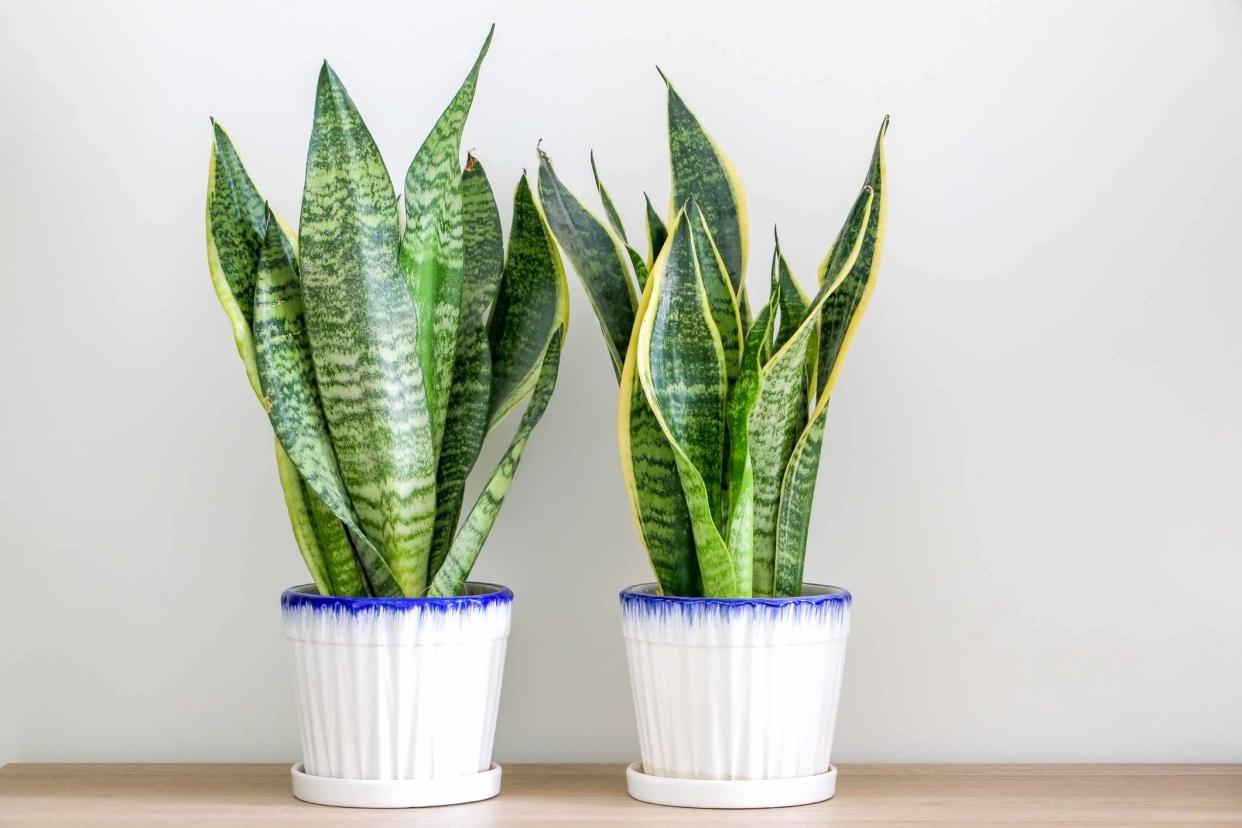Are Snake Plants Toxic to Dogs?

Adam Yee / Getty Images
Fact checked by Sarah Scott
Snake plants (Dracaena trifasciata) are popular houseplants known for their tough, long, succulent, grass-like foliage, as well as easy maintenance. They are known to be tolerant of neglect, making them an excellent choice for beginner houseplant collectors. However, despite their unique looks and their tough nature, many people wonder if it is safe to keep these plants in a home with dogs. Unfortunately, snake plants are toxic and should be kept out of the reach of dogs and cats. They are also toxic to humans so the same applies if you have small children.
Until 2017, the botanical name of the plant was Sansevieria trifasciata and many sources still list it under that old name. The plants are also known under the common name of mother-in-law’s tongue, golden bird’s nest, or viper’s bowstring hemp.
9 Popular Houseplants That Are Toxic to Dogs
Toxicity
Snake plants are considered mildly to moderately toxic to dogs. They contain saponins, which cause hypersalivation, dilated pupils, and gastrointestinal distress. It is found in the leaves of the snake plant, and it is most harmful when ingested in large quantities. Ingesting small amounts usually results in less severe symptoms, while ingesting large amounts may be more serious.
Symptoms of Snake Plant Poisoning in Dogs
Common symptoms of snake plant poisoning include nausea, vomiting, and diarrhea. Watch for any signs that your dog is acting out of the ordinary or that he or she is experiencing gastrointestinal distress.
Warning
If you suspect that your dog has ingested part of your snake plant, contact your vet or emergency animal hospital immediately. Do not induce vomiting unless instructed to by a professional. If possible, identify the variety of snake plant that was ingested, or bring in a picture or piece of the plant for the vet to see. In the meantime, keep a close eye on your dog and be sure to keep him or her from ingesting any more of the plant.
How to Prevent Your Dog From Eating Your Snake Plant
The tough nature of the snake plant and its ability to thrive in low-light environments means it’s well-suited for many locations in the home. A good way to keep your dog from eating your snake plant is to move it to an area that the dog cannot reach, such as on a high shelf or a tall plant stand. Do the same if you move the plant outdoors for the summer.
You could also move the plant to a room that your dog is not allowed to enter. If your furry friend is known for getting into trouble and you are concerned about him still finding a way to munch on your snake plant, you might have to resort to giving it to a friend.
Non-Toxic Alternatives to Snake Plants
Sometimes the best way to prevent your dog from consuming a toxic houseplant is by buying non-toxic plants. Even if curiosity gets the better of your dog and he does treat your houseplants like a snack, there is no harm done—except to the plant itself. Here are some non-toxic plants for pets that make great alternatives to a snake plant.
Cast Iron Plant: These unique, tall plants sport similar sword-like foliage as snake plants, but are nontoxic to dogs. They also thrive in low-to-medium light and are known for being just as hardy and difficult to kill. This makes the cast iron plant a perfect alternative.
Ponytail Palm: These plants are known for their large, round trunks and cascading grass-like foliage. They are drought-tolerant and do very well with minimum care and maintenance.
Spider Plant: Another grass-like, spiky-foliage houseplant, spider plants are a very popular nontoxic plant. Their yellow and green striped leaves have a similar color pattern as the snake plant. They are most famous for their dangling, spider-like offshoots, or baby spider plants. This unique feature makes them look lovely when hung from the ceiling or set on a high shelf.
Zebra Calathea: This plant offers striking zebra-like striped foliage and can reach two to three feet tall. Although this plant needs more water and humidity, it offers eye-catching foliage that makes a great replacement for the striped foliage of the snake plant.
Frequently Asked Questions
What happens if my dog eats a snake plant?
The toxic saponin in the plant has a foaming action which leads to mild to severe gastrointestinal upset, including nausea, vomiting, and diarrhea, in severe cases also ruptured red blood cells. Contact your veterinarian as soon as possible.
How toxic are snake plants?
All parts of the plant are toxic if ingested. The severity of the symptoms depends on the amount; large amounts can be fatal. Even the ingestion of small amounts should be taken seriously and treated as soon as possible.
Can my dog be in the same room as a snake plant?
The plant is not toxic upon contact, only when ingested. Whether you can leave the dog in the same room the plant depends on the location of the plant and the age and temperament of the dog. A puppy might be able to climb up on a plant stand whereas an older dog lacks the curiosity and agility. To be safe, it is not recommended to leave a dog unsupervised in a room with a snake plant within reach.
How long does it take for a dog to show signs of poisoning from a snake plant?
The symptoms typically show fairly quickly when the toxic saponin has reached the gastrointestinal tract of your dog.
Read the original article on The Spruce.

